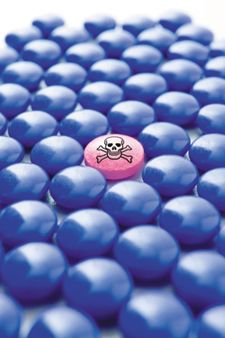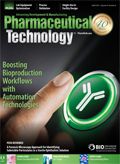Synchronizing Anticounterfeiting Efforts
Serialization and complementary authentication technologies are needed in order to meet DSCSA and FMD regulations.
Image Point Fr/shutterstock.com

Fake pharmaceuticals continue to have an impact on people and economies throughout the world. Legal penalties for counterfeiting prescription drugs remain lax, the cost of entering the market is low, and the profits extremely high. According to one estimate, a criminal investing $1000 in fake prescription drugs can expect to earn returns of $30,000, 10-times higher than what they might gain from trafficking a comparable investment in heroin (1).
As more criminals enter the business, counterfeit drugs are making a dent in economies, even in regions and countries with strict controls and regulations. In the European Union, for example, a study by the European Patent Office (EPO) and the EU Intellectual Property Office (EUIPO) suggested the impact that counterfeit drugs have on the economy and employment (2).
In 2013, the study found the EU pharmaceutical industry lost more than 4% of direct total sales, some €10.2 billion in revenue, to drug counterfeiting. Countries hardest hit by counterfeiting were said to be Spain, where fakes accounted for nearly 6% of sales, and Italy, where they accounted for 4%. Germany and France each lost approximately €1 billion in direct sales, according to the study.
For the EU as a whole, the study found that lost sales translated into 37,700 lost jobs, with nearly 7000 jobs lost in Germany, and between 3000 and 4000 pharma sector jobs lost in Italy, France, and Spain. Including indirect effects, pharmaceutical counterfeits resulted in approximately €17.3 billion in lost revenue to the EU economy, leading to additional losses of 53,200 jobs.
In the United States, the National Association of Boards of Pharmacy has estimated that counterfeit drugs generated $75 billion in revenues in 2010, which translates into $18 billion in lost industry profits (3).
According to the US Office of the United States Trade Representative (USTR) 2017 Special Report (4) issued in May 2017, traffic in counterfeit pharmaceutical and biopharmaceutical products, and active ingredients, continues. In 2016, the USTR reports, 90% of the counterfeit pharmaceuticals seized by the US government were found to have come from China, Hong Kong, India, and Singapore. In 2016, 16% of 31,560 US government seizures of counterfeit goods involved pharmaceuticals, down roughly 3% from 2015, when 5196 fake drug shipments were seized (5).
Increased reliance on express mail
Counterfeiters no longer ship fake drugs as cargo, the USTR report says, but send them in small quantities via legitimate express mail. In 2016, more than 90% of US counterfeit pharmaceuticals seized at the borders were found in express carrier and mail, the USTR report said.
Even counterfeit active ingredients are being shipped via express mail, for processing in “facilities,” in apartments, houses or garages, often using crude, outdated, and unsanitary equipment, according to a report that described scenarios that EU enforcement officials are more frequently seeing (6).
In September 2016, for example, authorities in Poland shut down a large counterfeit pharmaceutical operation that included 48 pieces of equipment including pharmaceutical mixers, tablet presses, and label printers, the report said. This operation sourced partially processed products from China, Greece, Romania, and the United Kingdom, and finished processing them on this equipment to “manufacture” fake erectile dysfunction treatments, anabolic steroids, and other counterfeit pharmaceutical products. This single operation was selling millions of Euros worth of products, and it is only one of many, in a constantly changing environment.
Lack of stiff criminal penalties is a major reason why counterfeit pharmaceuticals remain such a presence on the global market, the report says. Even in the US, attorney Sheldon Bradshaw noted, in a March 2017 legal position paper (7), penalties for counterfeiting remain in a catchall that lumps sales of unapproved drugs (that may be approved in other countries), substandard drugs, and intentionally counterfeited products. The result, he writes, is an enforcement “whack-a-mole” situation in which one illegal operation is shut down, but others take its place.
Can pharma meet new mandates?
Despite these challenges, regulations have been in force for the past few years to help pharmaceutical manufacturers stem the tide of counterfeit drugs reaching the patient.
The US Drug Supply Chain Safety Act (DSCSA) and the EU Falsified Medicines Directive (FMD) aim to ensure the safety of the pharmaceutical supply chain. Complying with these regulations requires different, but overlapping strategies (see
Sidebar).
Both DSCSA and FMD require use of serialization and improvements in IT and electronic data management to enable supply chain traceability. Large pharmaceutical companies have been working on the systems required for several years, and most are ready to meet legal requirements.
Some companies still haven’t serialized or upgraded IT for traceability
A number of pharma companies and contract maufacturing organizations may not be ready, however. According to a survey of both these groups by the serialization system provider SEA Vision and the life-sciences IT company Zenith Technology, 36% of respondents were not even working toward meet serialization requirements (8).
Besides, most pharmaceutical brand protection experts agree that serialization alone will not be enough to secure their supply chains. “It should be combined with other technologies,” says Bob Migliani, chief of business development for Applied DNA Sciences, Inc. His company offers SigNature DNA, a marker that can be traced at parts-per-trillion levels, is being used in the textile industry, and has been used by global law enforcement departments and six US government agencies.
Instead of focusing on adding the marker directly to pharmaceutical formulations, Applied DNA is now evaluating its use in the inks that are used to print labels and bar codes on pharmaceutical packaging.
Complementary technologies
Offering complementary technologies is Systech, which provides serialization services to the pharmaceutical industry, as well as its own patented authentication solution, Unisecure, that compares scanned barcodes to an original “fingerprint” from when the label was first printed.
This year, a simulation study at St. James Hospital in Ireland involving Systech, Sharp Packaging Servicesfound that both end-to-end scanning and scanning at each transfer point in the supply chain (as required by the DSCSA) still allowed some counterfeit product to reach patients. The additional authentication step prevented counterfeit medicines from reaching patients in the simulation, however. These results underscore the importance of using serialization with complementary product authentication and anticounterfeiting technologies.
References
1. R. Ehrenberg, “Counterfeit Crackdown,” Science News, 2011;179:22-25.
2. EPO/EUIPO, “The Economic Cost of IPR Infringement in the Pharmaceutical Industry,” September 2016.
3. E. Blackstone et al., “The Health and Economic Effects of Counterfeit Drugs,” ahdonline.com, June 2014.
4. USTR, Special 301 Report, Office of the President of the United States, Office of the US Trade Representative, 2017, May 1, 2017.
5. US Department of Homeland Security,
, cpb.gov.
6. C. Ellis, “On Tap Europe: Organized Crime and Illicit Trade in Tobacco, Alcohol and Pharmaceuticals,” iog.org, February 2017.
7. S. Bradshaw, “Penalty Disparities Frustrate Protection of Consumers from Dangerous Counterfeit Drugs,” wlf.org, March 24, 2017.
8. “Survey Suggests That One-Third of Pharma Companies Aren’t Ready for Serialization,” pharmtech.com, May 16, 2007.
9. “Simulation Finds Weakness in System Designed to Spot Fake Drugs,” securingindustry.com, March 28, 2017.
Article Details
Pharmaceutical Technology
Vol. 41, No. 6
Pages: 62-65
Citation
When referring to this article, please cite it as A. Shanley, “Synchronizing Anticounterfeiting Efforts,” Pharmaceutical Technology 41 (6) 2017.
